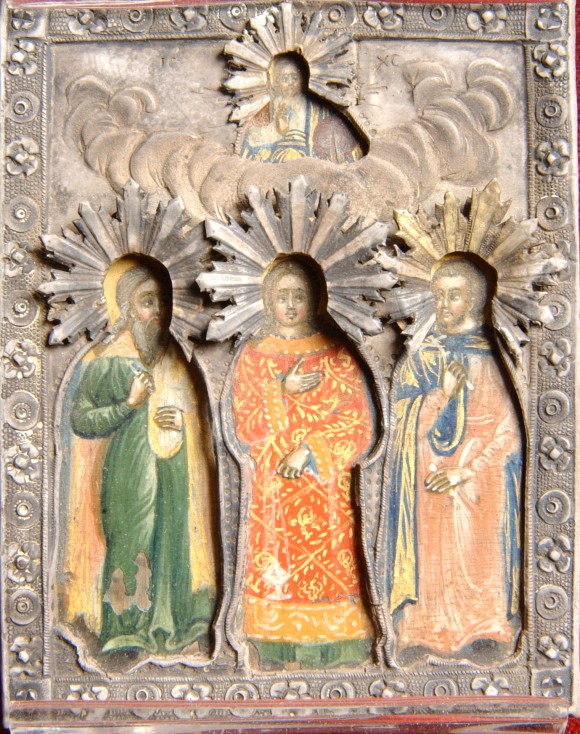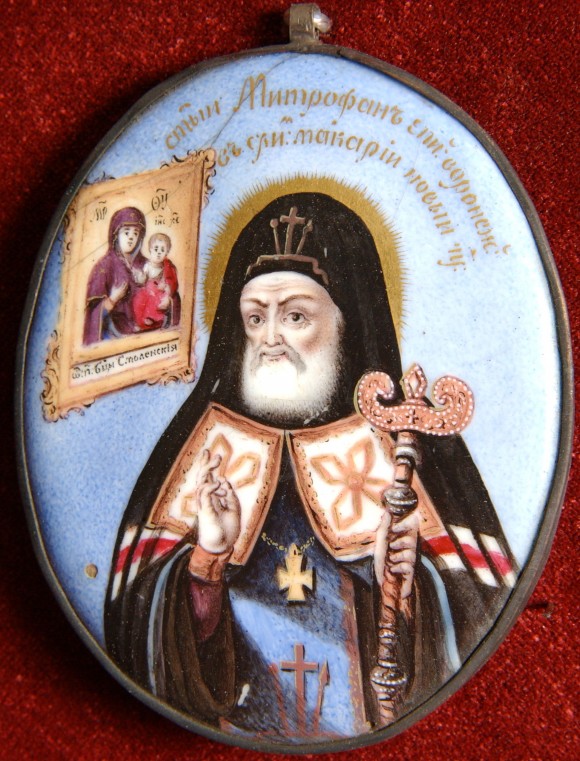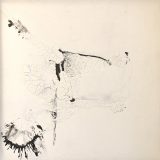The Art of Veneration Icons from the Russian Orhthodox Tradition
December 21, 2015

Artist Unknown,
Mother of God “Banish My Sorrows,”
Russia,
Tempera and gold leaf on panel, 19th century, Gift of Evelyn LeLanne
Function
In recognition of Christmas, we’re posting a selection of Russian icons from our collection. Icons play an important role in the Orthodox Christian faith, serving as manifestation of the divine world in our human one. Icons are displayed in both churches and private homes, and are even made in miniature forms for travel. While made to be beautiful and inspiring, the aesthetic value of icons is far secondary to their religious function, which is to create a place of worship and foster spiritual thought and experience.

Artist Unknown,
Holy Martyr St. Trifon,
Russian,
Tempera and gold leaf on panel, c. 1700,
Gift of Evelyn LaLanne

Artist Unknown,
Three Saints,
Russian,
Tempera on panel with silver cover, date unknown,
Gift of Evelyn LaLanne
Technique
Icons can take a variety of forms- they can be carved, embroidered, sculpted, or painted directly to a church wall. However, the most familiar form is tempera paint on wood panel. The panels are created from multiple boards of wood held together with additional struts on the back side. This is because a wood panel will warp over time. Paint cannot be applied directly to the surface of the wood because wood is so absorbent, so a mixture of chalk and glue called gesso is layered to create a hard and smooth surface. Tempera, which is made by mixing egg yolk and pigments, is then painted on in stages because of how quickly it dries. Finally, the whole painting is covered in a protective varnish made of resin. Often times, the icon is also adorned with an ornate metal cover.

Artist Unknown,
St. Mitrofan, Bishop of Voronezh,
Russian,
Painted Enamel, 1832,
Gift of Evelyn LaLanne,

Artist Unknown,
St. Nicholas the Miracle Worker,
Russian,
Tempera on panel, 16th century,
Gift of Evelyn LaLanne
Images of the Saints
The Russian Orthodox Church inherited many of its saints from Byzantium, when the Kievan state converted to Christianity in 988. Thus, St. George became the patron saint of Moscow, St. Paraskeva presided over trade and women’s affairs, and St. Nicholas (“Nikola”) became a universal protector of the Russian people. Over time, Russian Orthodoxy acquired its own saints, such as Leontii of Rostov and Mitrofan of Voronezh.

Artist unknown,
Kazan Mother of God,
Russian,
Tempera on panel with silver and freshwater pearls covering, late 19th century,
Gift of Evelyn LaLanne

Artist unknown,
Vladimir Mother of God,
Russian,
Tempera on panel with bronze covering, late 19th century,
Gift of Evelyn LaLanne

Artist unknown,
Mother of God “The Burning Bush”,
Russian,
Tempera on panel, late 19th century,
Gift of Evelyn LaLanne
Images of the Mother of God
The Virgin Mary (or Mother of God, as she is referred to in Orthodoxy) is a common subject of Russian icons, with some 300 distinct types of her image in existence. The most revered in Russia were the Kazan, Vladimir, and Smolensk Mother of God, each derived from an original icon that was associated with a particular city and believed to be miracle-working. Different icons depicting the Mother of God can be identified by the pose of Mary and infant Jesus and by such nuances as the tilt of the head or the position of the child’s feet. The intercessory role of Mary in the lives of the faithful was integral to her icons. The “Burning Bush” Mother of God was believed to guard against fires, while the Mother of God “Joy to Those Who Grieve” comforted the poor and dispossessed.

Artist unknown,
Christ Not Made by Hands,
Russian,
Tempera on panel, c. 1700,
Gift of Evelyn LaLanne
Images of Christ
Images of Christ lie at the heart of icon veneration, as the visible manifestation of his human nature. Icons of Christ Pantocrator (“Christ All-powerful”) and the Savior Not Made by Hands are among the most frequently encountered. The festival icons that represent the 12 major episodes of Jesus’s life occupy the central row in the sanctuary screen (iconostasis) of every Orthodox church, while the Deisis (Christ flanked by Mary and John the Baptist) marks the focal point of the worshipper’s prayers.



